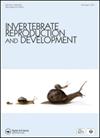微卫星分析揭示猪水蛭的繁殖效率和多重亲子关系
IF 0.8
4区 生物学
Q4 REPRODUCTIVE BIOLOGY
引用次数: 4
摘要
摘要:猪瘟在中医中被用于治疗心血管疾病和其他慢性疾病,但其繁殖行为尚未得到很好的研究。本研究的目的是研究猪的繁殖效率和交配系统。这项研究是在实验室条件下进行的。总共使用了28只重22.3±6.1克的妊娠水蛭。水蛭体重减轻46.68±9.89%,结茧6.00±0.82个。茧长20.93±4.84mm,直径17.20±4.41mm,孵化30.97±11.19只。平均每只水蛭孵化182.70±51.16只。产卵期与茧大小呈显著负相关。通过用6个微卫星基因座对10只成年水蛭及其200只后代(每只水蛭20只后代)进行基因分型,观察到所有家族的多重亲子关系。我们推断每个家庭至少有2-5个配偶,平均3.30±0.95个配偶。这是第一个直接的证据表明多个父亲在W.pigra。这一结果将有助于水蛭的自然生产和保护。本文章由计算机程序翻译,如有差异,请以英文原文为准。
Reproduction efficiency of the leech Whitmania pigra and multiple paternity revealed by microsatellite analyses
ABSTRACT Whitmania pigra is used in traditional Chinese medicine for the treatment of cardiovascular diseases and other chronic diseases, but its reproductive behaviour has not been well studied. The purpose of this study was to investigate the reproduction efficiency and mating system of W. pigra. The study was conducted under laboratory conditions. A total of 28 gravid leeches weighing 22.3 ± 6.1 g were used. The leeches deposited 6.00 ± 0.82 cocoons by losing 46.68 ± 9.89% in body weight. The cocoons, with a length of 20.93 ± 4.84 mm and diameter of 17.20 ± 4.41 mm, had 30.97 ± 11.19 hatchlings. An average of 182.70 ± 51.16 hatchlings per leech were obtained from the leeches. There was a significant negative correlation between the cocoon laying period and cocoon size. By genotyping 10 adult leeches and 200 of their offspring (20 offspring per leech) with six microsatellite loci, multiple paternity was observed for all families. We inferred a minimum of 2–5 mates per family, with an average of 3.30 ± 0.95 mates. This was the first direct evidence of multiple paternity in W. pigra. This result will be useful inartificial production and conservation of the leech W. pigra.
求助全文
通过发布文献求助,成功后即可免费获取论文全文。
去求助
来源期刊
CiteScore
1.90
自引率
0.00%
发文量
21
审稿时长
>12 weeks
期刊介绍:
Invertebrate Reproduction & Development ( IRD) presents original research on the reproductive and developmental biology of the Invertebrata, both embryonic and postembryonic. IRD welcomes papers reporting significant results obtained using new techniques. Encouraged topic areas include: aquaculture, physiology, biochemistry, functional morphology, phylogeny, behavioural and regulatory mechanisms, including genetic, endocrine and molecular studies. Papers containing qualitative descriptions of reproductive cycles and gametogenesis will not be considered. IRD is published in association with the International Society of Invertebrate Reproduction and Development.

 求助内容:
求助内容: 应助结果提醒方式:
应助结果提醒方式:


